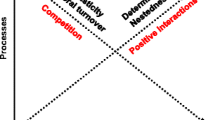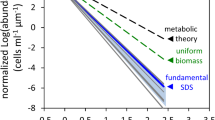Abstract
Coexistence theory predicts that, in general, increases in the number of limiting resources shared among competitors should facilitate coexistence. Heterotrophic sessile marine invertebrate communities are extremely diverse but traditionally, space was viewed as the sole limiting resource. Recently planktonic food was recognized as an additional limiting resource, but the degree to which planktonic food acts as a single resource or is utilized differentially remains unclear. In other words, whether planktonic food represents a single resource niche or multiple resource niches has not been established. We estimated the rate at which 11 species of marine invertebrates consumed three phytoplankton species, each different in shape and size. Rates of consumption varied by a 240-fold difference among the species considered and, while there was overlap in the consumer diets, we found evidence for differential resource usage (i.e. consumption rates of phytoplankton differed among consumers). No consumer ingested all phytoplankton species at equivalent rates, instead most species tended to consume one of the species much more than others. Our results suggest that utilization of the phytoplankton niche by filter feeders is more subdivided than previously thought, and resource specialization may facilitate coexistence in this system. Our results provide a putative mechanism for why diversity affects community function and invasion in a classic system for studying competition.


Similar content being viewed by others
References
Adler PB, Ellner SP, Levine JM (2010) Coexistence of perennial plants: an embarrassment of niches. Ecol Lett 13:1019–1029
Angert AL, Huxman TE, Chesson P, Venable DL (2009) Functional tradeoffs determine species coexistence via the storage effect. Proc Nat Acad Sci 106:11641–11645
Bakdash J, Marusich L (2017) Repeated measures correlation. Front Psychol 8:1–13
Best M, Thorpe J (1986) Feeding-current interactions and competition for food among the bryozoan epiphytes of Fucus serratus. Mar Biol 93:371–375
Buss LW (1979) Bryozoan overgrowth interactions—the interdependence of competition for space and food. Nature 281:475
Buss L (1980) Competitive intransitivity and size-frequency distributions of interacting populations. Proc Natl Acad Sci 77:5355–5359
Buss LW, Jackson JB (1981) Planktonic food availability and suspension-feeder abundance: evidence of in situ depletion. J Exp Mar Biol Ecol 49:151–161
Butler A, Chesson P (1990) Ecology of sessile animals on sublittoral hard substrata: the need to measure variation. Aust J Ecol 15:521–531
Chesson P (2000) Mechanisms of maintenance of species diversity. Annu Rev Ecol Syst 31:343–366
Ciite J, Himmelman JH, Claereboudt MR (1994) Separating effects of limited food and space on growth of the giant scallop Placopecten magellanicus in suspended culture. Mar Ecol Prog Ser 106:85–91
Clavel J, Julliard R, Devictor V (2011) Worldwide decline of specialist species: toward a global functional homogenization? Front Ecol Environ 9:222–228
Compton TJ, Troost TA, van der Meer J, Kraan C, Honkoop PJC, Rogers DI, Pearson GB, de Goeij P, Bocher P, Lavaleye MSS, Leyrer J, Yates MG, Dekinga A, Piersma T (2008) Distributional overlap rather than habitat differentiation characterizes co-occurrence of bivalves in intertidal soft sediment systems. Mar Ecol Prog Ser 373:25–35
Connell JH (1961) The influence of interspecific competition and other factors on the distribution of the barnacle Chthamalus stellatus. Ecology 42:710–723
Cresson P, Ruitton S, Harmelin-Vivien M (2016) Feeding strategies of co-occurring suspension feeders in an oligotrophic environment. Food Webs 6:19–28
Dalby JE (1995) Consequences of aggregated living in the ascidian Pyura stolonifera: evidence for non-contact intraspecific competition. Mar Freshw Res 46:1195–1199. https://doi.org/10.1071/mf9951195
Dubois S, Orvain F, Marin-Léal JC, Ropert M, Lefebvre S (2007) Small-scale spatial variability of food partitioning between cultivated oysters and associated suspension-feeding species, as revealed by stable isotopes. Mar Ecol Prog Ser 336:151–160
Ferguson N, White CR, Marshall DJ (2013) Competition in benthic marine invertebrates: the unrecognized role of exploitative competition for oxygen. Ecology 94:126–135
Fox J, Barreto C (2006) Surprising competitive coexistence in a classic model system. Community Ecol 7:143–154
Freestone AL, Inouye BD (2015) Nonrandom community assembly and high temporal turnover promote regional coexistence in tropics but not temperate zone. Ecology 96:264–273
Ghedini G, White CR, Marshall DJ (2017) Does energy flux predict density-dependence? An empirical field test. Ecology 98:3116–3126
Ghedini G, Loreau M, White CR, Marshall DJ (2018) Testing MacArthur’s minimisation principle: do communities minimise energy wastage during succession? Ecol Lett 21:1182–1190
Gherardi LA, Sala OE, Yahdjian L (2013) Preference for different inorganic nitrogen forms among plant functional types and species of the Patagonian steppe. Oecologia 173:1075–1081
Götzenberger L, de Bello F, Bråthen KA, Davison J, Dubuis A, Guisan A, Leps J, Lindborg R, Moora M, Pärtel M, Pellissier L, Pottier J, Vittoz P, Zobel K, Zobel M (2012) Ecological assembly rules in plant communities—approaches, patterns and prospects. Biol Rev 87:111–127
Guillard RR (1975) Culture of phytoplankton for feeding marine invertebrates. Culture of marine invertebrate animals. Springer, Boston, pp 29–60
Hallegraeff GM, Bolch CJS, Hill DRA, Jameson I, LeRoi JM, McMinn A, Murray S, Salas MF, Saunders K (2010) Algae of Australia: phytoplankton of temperate coastal waters. CSIRO Publishing, Collingwood
Hart SP, Marshall DJ (2012) Advantages and disadvantages of interference-competitive ability and resource-use efficiency when invading established communities. Oikos 121:396–402
Hart SP, Schreiber SJ, Levine JM (2016) How variation between individuals affects species coexistence. Ecol Lett 19:825–838
HilleRisLambers J, Adler PB, Harpole WS, Levine JM, Mayfield MM (2012) Rethinking community assembly through the lens of coexistence theory. Annu. Rev. Ecol. Evol. Syst. 43:227–248
Hutchinson GE (1961) The paradox of the plankton. Am Nat 95:137–145
Jorgensen C, Kiorboe T, Mohlenberg F, Riisgard H (1984) Ciliary and mucus-net filter feeding, with special reference to fluid mechanical characteristics. Mar Ecol Prog Ser 15:283–292
Keough MJ (1984) Effects of patch size on the abundance of sessile marine-invertebrates. Ecology 65:423–437. https://doi.org/10.2307/1941405
Kim K, Lasker HR (1997) Flow-mediated resource competition in the suspension feeding gorgonian Plexaura homomalla (Esper). J Exp Mar Biol Ecol 215:49–64
Lagos ME, Barneche DR, White CR, Marshall DJ (2017) Do low oxygen environments facilitate marine invasions? Relative tolerance of native and invasive species to low oxygen conditions. Glob Change Biol 23:2321–2330
Lagos ME, White CR, Marshall DJ (2017) Do invasive species live faster? Mass-specific metabolic rate depends on growth form and invasion status. Funct Ecol 31:2080–2086
Lesser MP, Shumway SE, Cucci T, Smith J (1992) Impact of fouling organisms on mussel rope culture: interspecific competition for food among suspension-feeding invertebrates. J Exp Mar Biol Ecol 165:91–102
Letten AD, Dhami MK, Ke P-J, Fukami T (2018) Species coexistence through simultaneous fluctuation-dependent mechanisms. Proc Natl Acad Sci 115:6745–6750
McDonald J (2004) The invasive pest species Ciona intestinalis (Linnaeus, 1767) reported in a harbour in southern Western Australia. Mar Pollut Bull 49:868–870
McKane RB, Johnson LC, Shaver GR, Nadelhoffer KJ, Rastetter EB, Fry B, Giblin AE, Kielland K, Kwiatkowski BL, Laundre JA, Murray G (2002) Resource-based niches provide a basis for plant species diversity and dominance in arctic tundra. Nature 415:68–71
Okamura B (1990) Particle size, flow velocity, and suspension-feeding by the erect bryozoans Bugula neritina and B. stolonifera. Mar Biol 105:33–38
Oksanen J, Blanchet FG, Friendly M, Kindt R, Legendre P, McGlin D, Minchin PR, O'Hara RB, Simpson GL, Solymos P, Stevens MHH, Szoecs E, Wagner H (2013) Package ‘vegan’. Community ecology package, version 2:1–295
Paine RT (1966) Food web complexity and species diversity. Am. Nat. 100:65–75
Palardy JE, Witman JD (2011) Water flow drives biodiversity by mediating rarity in marine benthic communities. Ecol Lett 14:63–68
Pavoine S, Bonsall M (2011) Measuring biodiversity to explain community assembly: a unified approach. Biol Rev 86:792–812
Petersen JK (2007) Ascidian suspension feeding. J Exp Mar Biol Ecol 342:127–137
Pratt MC (2008) Living where the flow is right: How flow affects feeding in bryozoans. Integr Comp Biol 48:808–822
Quinn GP, Keough MJ (2002) Experimental design and data analysis for biologists. Cambridge University Press, Cambridge
Riisgård HU, Larsen PS (2010) Particle capture mechanisms in suspension-feeding invertebrates. Mar Ecol Prog Ser 418:255–293
Russ GR (1982) Overgrowth in a marine epifaumal community: competitive hierarchies and competitive networks. Oecologia 53:12–19
Schoener TW (1974) Resource partitioning in ecological communities. Science 185:27–39
Sousa WP (1979) Disturbance in marine intertidal boulder fields: the nonequilibrium maintenance of species diversity. Ecology 60:1225–1239
Stachowicz JJ, Best RJ, Bracken ME, Graham MH (2008) Complementarity in marine biodiversity manipulations: reconciling divergent evidence from field and mesocosm experiments. Proc Natl Acad Sci 105:18842–18847
Stachowicz JJ, Whitlatch RB, Osman RW (1999) Species diversity and invasion resistance in a marine ecosystem. Science 286:1577–1579
Stuart V, Klumpp D (1984) Evidence for food-resource partitioning by kelp-bed filter feeders. Mar Ecol Prog Ser Oldendorf 16:27–37
Svensson JR, Marshall DJ (2015) Limiting resources in sessile systems: food enhances diversity and growth of suspension feeders despite available space. Ecology 96:819–827
Tilman D (2004) Niche tradeoffs, neutrality, and community structure: a stochastic theory of resource competition, invasion, and community assembly. Proc Natl Acad Sci U S A 101:10854–10861
Usinowicz J, Chang-Yang CH, Chen YY, Clark JS, Fletcher C, Garwood NC, Hao Z, Johnstone J, Lin Y, Metz MR, Masaki T, Nakashizuka T, Sun IF, Valencia R, Wang Y, Zimmerman JK, Ives AR, Wright SJ (2017) Temporal coexistence mechanisms contribute to the latitudinal gradient in forest diversity. Nature 550:105–108
Whalen MA, Stachowicz JJ (2017) Suspension feeder diversity enhances community filtration rates in different flow environments. Mar Ecol Prog Ser 570:1–13
Wilson M, Lindow SE (1994) Coexistence among epiphytic bacterial populations mediated through nutritional resource partitioning. Appl Environ Microbiol 60:4468–4477
Young HS, Shaffer SA, McCauley DJ, Foley DG, Dirzo R, Block BA (2010) Resource partitioning by species but not sex in sympatric boobies in the central Pacific Ocean. Mar Ecol Prog Ser 403:291–301
Acknowledgements
We are grateful to the Royal Brighton Yacht Club, Royal Melbourne Yacht Squadron and Blairgowrie Yacht Squadron for access to their marinas. We thank M. Malerba for his laboratory assistance and A. Pettersen and G. Ghedini for their assistance in the preparation of this manuscript.
Author information
Authors and Affiliations
Contributions
BC and DM designed the study. BC conducted the experiments and data collection. BC, DM and MAN analysed the data, contributed to the writing and drafting of the manuscript and gave final approval for publication.
Corresponding author
Ethics declarations
Conflict of interest
The authors declare that they have no conflict of interest.
Statement of human and animal rights
All applicable institutional and/or national guidelines for the care and use of animals were followed.
Additional information
Communicated by Joel Trexler.
Electronic supplementary material
Below is the link to the electronic supplementary material.
Rights and permissions
About this article
Cite this article
Comerford, B., Álvarez-Noriega, M. & Marshall, D. Differential resource use in filter-feeding marine invertebrates. Oecologia 194, 505–513 (2020). https://doi.org/10.1007/s00442-020-04791-w
Received:
Accepted:
Published:
Issue Date:
DOI: https://doi.org/10.1007/s00442-020-04791-w




